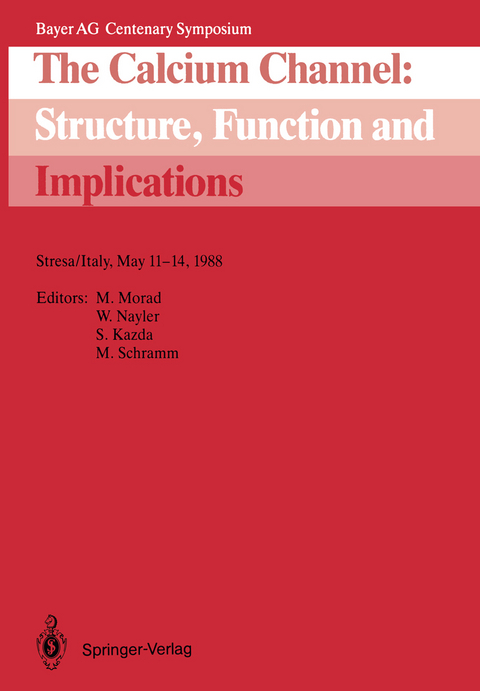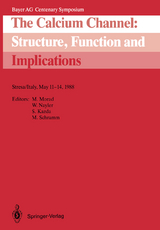The Calcium Channel: Structure, Function and Implications
Springer Berlin (Verlag)
978-3-540-50061-2 (ISBN)
History and Philosophy of Bayer Pharmaceutical Research.- The Effect of Lime and Potash on the Frog Heart: An Imaginative Reconstruction of a Paper Presented by Sydney Ringer to the Physiological Society on 9th December 1882.- Homology of Calcium-Modulated Proteins: Their Evolutionary and Functional Relationships.- 1 The Function of the Calcium Channel.- Kinetics, and ?-Adrenergic Modulation of Cardiac Ca2+ Channels.- Dihydropyridines, G Proteins, and Calcium Channels.- Electrophysiology of Dihydropyridine Ca Agonists.- Proton-Induced Transformation of Ca2+-Channel: Possible Mechanism and Physiological Role.- Membrane Potential and Dihydropyridine Block of Calcium Channels in the Heart: Influence of Drug Ionization on Blocking Activity.- Dihydropyrine-Sensitive and Insensitive Ca2+ Channels in Normal and Transformed Fibroblasts.- Protein Phosphorylation and the Inactivation of Dihydropyridine-Sensitive Calcium Channels in Mammalian Pituitary Tumor Cells.- Sodium Currents Through Neuronal Calcium Channels: Kinetics and Sensitivity to Calcium Antagonists.- Block of Sodium Currents Through a Neuronal Calcium Channel by External Calcium and Magnesium Ions.- The Voltage Sensor of Skeletal Muscle Excitation-Contraction Coupling: A Comparison with Ca2+ Channels.- 2 The Structure of the Calcium Channel.- Biochemistry and Molecular Pharmacology of Ca2+ Channels and Ca2+-Channel Blockers.- The Structure of the Ca2+ Channel: Photoaffinity Labeling and Tissue Distribution.- Site-Specific Phosphorylation of the Skeletal Muscle Receptor for Calcium-Channel Blockers by cAMP-Dependent Protein Kinase.- Molecular Properties of Dihydropyridine-Sensitive Calcium Channels from Skeletal Muscle.- Molecular Characterization of the 1,4-Dihydropyridine Receptor in Skeletal Muscle.-Reconstitution of Solubilized and Purified Dihydropyridine Receptor from Skeletal Muscle Microsomes as Two Single Calcium-Channel Conductances with Different Functional Properties.- 1,4-Dihydropyridines as Modulators of Voltage-Dependent Calcium-Channel Acitivity.- Dihydropyridine Pharmacology of the Reconstituted Calcium Channel of Skeletal Muscle.- Expression of mRNA Encoding Rat Brain Ca2+ Channels in Xenopus Oocytes.- 3 Calcium Channels in the Cardiovascular and Endocrine System.- Ca2+ Pathways Mediating Agonist-Activated Contraction of Vascular Smooth Muscle and EDRF Release from Endothelium.- Calcium Channels and the Heart.- Role of Calcium Channels in Cardiac Arrythmias.- General Anaesthetics and Antiarrhythmics Antagonize the Ca2+ Current in Single Frog Cardiac Cells.- The Calcium Channel and Vascular Injury.- Endocrine Effects of Calcium Channel Agonists and Antagonists in a Pituitary Cell System.- L-Type Calcium Channels and Adrenomedullary Secretion.- Regulation of Signal Transduction by G Proteins in Exocrine Pancreas Cells.- Calcium Channel Blockers and Renin Secretion.- Action of Parathyroid Hormone on Calcium Transport in Rat Brain Synaptosomes is Independent of cAMP.- Calcium and the Mediation of Tubuloglomerular Feedback Signals.- Inhibition of Parathyroid Hormone Secretion by Calcium: The Role of Calcium Channels.- 4 Neuropharmacology of Calcium-Channels.- The Neuropharmacology of Ca2+ Channels.- Kinetic Characteristics of Different Calcium Channels in the Neuronal Membrane.- Increased Calcium Currents in Rat Hippocampal Neurons During Aging.- Regulation of Brain 1,4-Dihydropyridine Receptors by Drug Treatment.- Nimodipine and Neural Plasticity in the Peripheral Nervous System of Adult and Aged Rats.- Anticonvulsant Properties of Dihydropyridine Calcium Antagonists.- Interaction Between Certain Antipsychotic Drugs and Dihydropyridine Receptor Sites.- Effects of Organic Calcium-Entry Blockers on Stimulus-Induced Changes in Extracellular Calcium Concentration in Area CA 1 of Rat Hippocampal Slices.- Alcohol, Neurodegenerative Disorders and Calcium-Channel Antagonist Receptors.- 5 Endogenous Ligands and Antibodies.- Endogenous Ligands for the Calcium Channel: Myths and Realities.- Endogenous 1,4-Dihydropyridine-Displacing Substances Acting on L-Type Ca2+ Channels: Isolation and Characterization of Fractions from Brain and Stomach.- Endothelium-Derived Novel Vasoconstrictor Peptide Endothelin: A Possible Endogenous Agonist for Voltage-Dependent Ca2+ Channels.- Calcium-Channel Antibodies: Subunit-Specific Antibodies as Probes for Structure and Function.- Endogenous Ligands for Voltage-Sensitive Calcium Channels in Extracts of Rat and Bovine Brain.- An Endogenous Purified Peptide Modulates Ca2+ Channels in Neurons and Cardiac Myocytes.- Antibodies Against the ADP/ATP Carrier Interact with the Calcium Channel and Induce Cytotoxicity by Enhancement of Calcium Permeability.- Calcium, Aging and Disease.- Calcium, Aging and Diseases.
| Erscheint lt. Verlag | 24.11.1988 |
|---|---|
| Reihe/Serie | Bayer AG Centenary Symposium |
| Zusatzinfo | XXVII, 643 p. 73 illus. |
| Verlagsort | Berlin |
| Sprache | englisch |
| Maße | 170 x 244 mm |
| Gewicht | 1220 g |
| Themenwelt | Medizinische Fachgebiete ► Innere Medizin ► Nephrologie |
| Medizin / Pharmazie ► Medizinische Fachgebiete ► Pharmakologie / Pharmakotherapie | |
| Medizin / Pharmazie ► Pharmazie | |
| Naturwissenschaften ► Biologie ► Biochemie | |
| Schlagworte | ATP • biochemistry • Calcium • cell membrane • Drug • endocrinology • Kinetics • Neuropharmacology • pharmacology • phosphorylation • Physiology • Protein • receptor • Research • Toxicity |
| ISBN-10 | 3-540-50061-8 / 3540500618 |
| ISBN-13 | 978-3-540-50061-2 / 9783540500612 |
| Zustand | Neuware |
| Haben Sie eine Frage zum Produkt? |
aus dem Bereich




